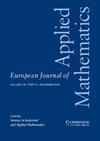利用合成孔径雷达恢复卫星光学图像的非标准增长条件变分模型
IF 2.3
4区 数学
Q1 MATHEMATICS, APPLIED
引用次数: 5
摘要
在本文中,研究了在没有关于云污染光学图像在损伤区域的亮度信息的情况下,云污染光学成像的恢复问题。我们提出了一种新的变分方法,用于利用合成孔径雷达精确恢复光学多波段图像(EOS–空间数据分析、GIS软件、卫星图像–是一个基于云的平台,用于导出遥感数据并分析卫星图像,用于商业和科学目的)。我们证明了解的存在性,提出了一种计算解的交替最小化方法,证明了该方法对原问题弱解的收敛性,并导出了最优性条件。本文章由计算机程序翻译,如有差异,请以英文原文为准。
Variational model with nonstandard growth conditions for restoration of satellite optical images using synthetic aperture radar
In this paper, the problem of restoration of cloud contaminated optical images is studied in the case when we have no information about brightness of such images in the damage region. We propose a new variational approach for exact restoration of optical multi-band images utilising Synthetic Aperture Radar (EOS – Spatial Data Analytics, GIS Software, Satellite Imagery – is a cloud-based platform to derive remote sensing data and analyse satellite imagery for business and science purposes) images of the same regions. We prove existence of solutions, propose an alternating minimisation method for computing them, prove convergence of this method to weak solutions of the original problem and derive optimality conditions.
求助全文
通过发布文献求助,成功后即可免费获取论文全文。
去求助
来源期刊
CiteScore
4.70
自引率
0.00%
发文量
31
审稿时长
>12 weeks
期刊介绍:
Since 2008 EJAM surveys have been expanded to cover Applied and Industrial Mathematics. Coverage of the journal has been strengthened in probabilistic applications, while still focusing on those areas of applied mathematics inspired by real-world applications, and at the same time fostering the development of theoretical methods with a broad range of applicability. Survey papers contain reviews of emerging areas of mathematics, either in core areas or with relevance to users in industry and other disciplines. Research papers may be in any area of applied mathematics, with special emphasis on new mathematical ideas, relevant to modelling and analysis in modern science and technology, and the development of interesting mathematical methods of wide applicability.

 求助内容:
求助内容: 应助结果提醒方式:
应助结果提醒方式:


